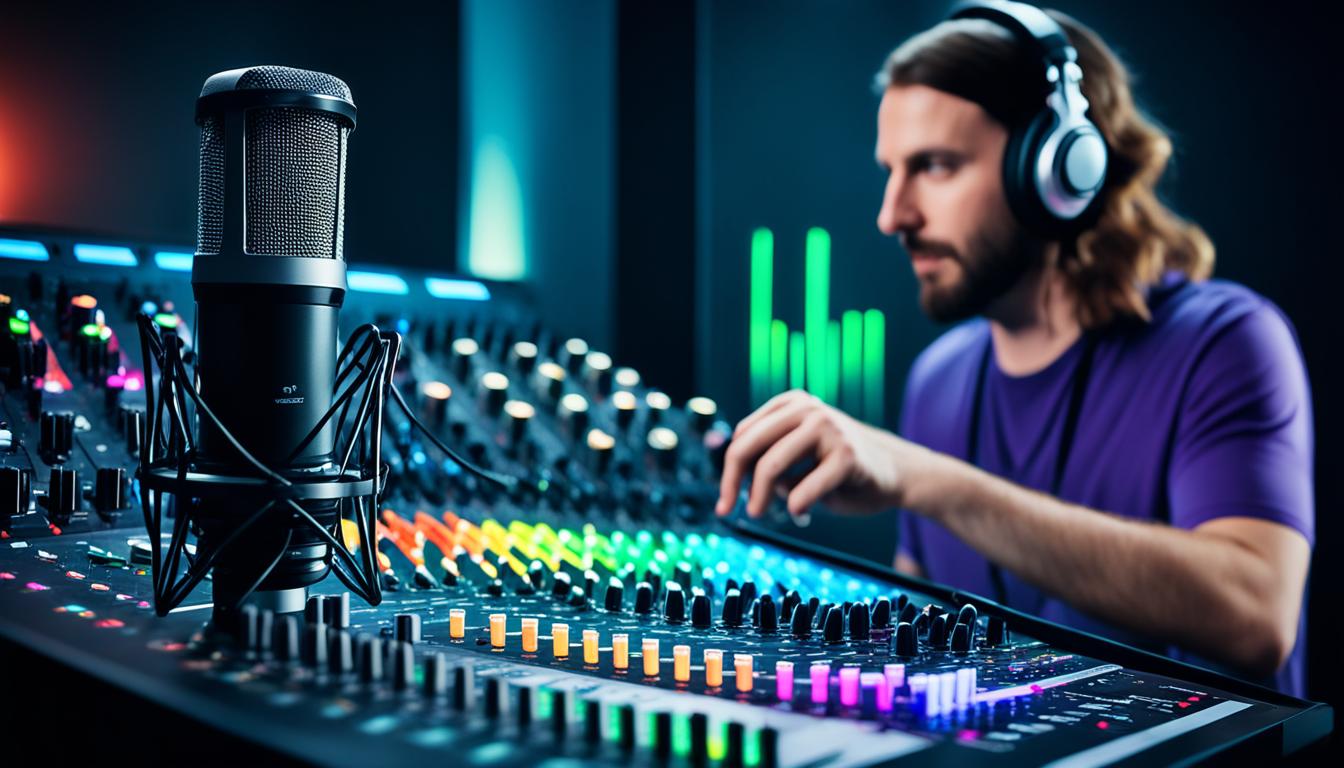When it comes to achieving seamless and high-quality audio post-production in film and TV, the mastery of advanced dubbing techniques is essential. These techniques encompass various aspects, including lip-syncing, voice-over techniques, and ADR (Automated Dialogue Replacement) in film. By honing these skills, audio professionals can elevate the overall viewing experience and ensure that the dubbed content resonates with the audience.
Whether it’s perfectly synchronizing lip movements or delivering lines with authenticity and clarity, mastering advanced dubbing techniques requires attention to detail and expertise in audio post-production. In this article, we will delve into the importance of lip-syncing, voice-over techniques, and the utilization of ADR in film to enhance the dubbing process.
Key Takeaways:
- Lip-syncing is crucial in dubbing to ensure the synchronization of audio and visuals.
- Voice-over techniques play a pivotal role in creating authentic and engaging performances.
- ADR in film allows for precise control over dialogue and improves the quality of dubbed content.
- Mastering advanced dubbing techniques enhances the viewer’s experience and elevates skills in the dubbing industry.
The Importance of Lip-Syncing in Dubbing
Lip-syncing plays a crucial role in the process of dubbing, ensuring that the dubbed dialogue accurately matches the lip movements of the actors on screen. This technique requires precise timing and coordination to achieve perfect synchronization between the audio and visuals. By focusing on lip-syncing, we can create a seamless viewing experience, giving the impression that the characters are speaking in their native language.
At its core, lip-syncing involves careful attention to detail and expertise in voice-over techniques. It is essential to analyze the lip movements of the actors and carefully time the delivery of the dubbed dialogue. This process ensures that the lip movements and speech are in perfect harmony, enhancing the believability of the dubbed content.
The art of lip-syncing goes beyond basic synchronization; it also involves capturing the nuances of the characters’ lip movements. By paying attention to the subtle variations in lip movement and expression, voice-over artists can bring authenticity to their performances. This level of attention ensures that the dubbed dialogue appears natural and convincing, seamlessly blending with the on-screen visuals.
“Lip-syncing is a crucial aspect of dubbing that involves matching the dubbed dialogue with the lip movements of the actors on screen.”
Mastering lip-syncing requires not only technical precision but also a deep understanding of the characters and their emotions. Voice-over artists must interpret the intentions behind the on-screen performances and convey them effectively through their dubbing. By capturing the emotions, tone, and articulation of the original dialogue, they bring life to the characters and engage the audience on a deeper level.
Overall, lip-syncing is a fundamental element in the dubbing process, bringing harmony and authenticity to the audio-visual experience. Through meticulous attention to lip movements and expert voice-over techniques, we can achieve seamless synchronization and create a captivating viewing experience for the audience.
Mastering Voice-Over Techniques for Dubbing
Voice-over techniques are vital in the dubbing process, allowing us to achieve effective and compelling dubbing that resonates with the audience. As voice-over artists, one of our primary goals is to accurately portray the emotions, tone, and intentions of the characters we dub. By understanding these aspects, we can deliver lines with authenticity, bringing the characters to life.
Articulation and enunciation are fundamental skills that voice-over artists must master. Clear and intelligible dialogue is crucial for ensuring that the dubbed content is easily understood by viewers. By effectively articulating every word and maintaining proper enunciation, we can maximize the clarity and impact of the dubbed lines.
The Importance of Emotion and Tone
When dubbing, it is essential to capture the emotional nuances of the original performance. By accurately conveying the character’s emotions, we can ensure that the dubbed dialogue maintains the intended impact. Whether it’s conveying joy, sadness, anger, or fear, our voice-over techniques must reflect these emotions, engaging the audience on a deeper level.
Tone is another aspect that deserves special attention. It sets the mood of the scene and dictates the character’s attitude and intentions. By matching the tone of the original performance, we can maintain the consistency and believability of the dubbed content.
Mastering Voice Modulation and Expression
Variety in voice modulation is key for creating realistic and engaging performances. By adjusting our voice’s pitch, pace, and volume, we can add depth and complexity to the characters we dub. It allows us to differentiate between different characters, emphasizing their unique personalities and traits.
Expression is another crucial element that brings the characters to life. By infusing our voice with the appropriate expression, we can effectively convey the subtleties and nuances of the dialogue. Expressive voice-over techniques make the dubbed content more relatable and captivating, ensuring that viewers are fully immersed in the story.
To become proficient in voice-over techniques for dubbing, practice is essential. Engaging in vocal exercises, working with experienced coaches, and continually refining our skills will help us deliver exceptional performances and elevate the quality of the dubbed content.

| Benefits of Mastering Voice-Over Techniques for Dubbing | Examples |
|---|---|
| Enhanced believability in the dubbed dialogue | By effectively conveying emotions and tone, the dubbed lines feel natural and believable. |
| Improved clarity and intelligibility | Mastering articulation and enunciation ensures that the dubbed dialogue is clear and easily understood by viewers. |
| Engaging and captivating performances | Voice modulation and expression add depth and complexity to the characters, keeping the audience captivated. |
| Elevated overall quality of the dubbed content | By honing our voice-over skills, we contribute to the seamless and high-quality dubbing experience. |
ADR in Film: Enhancing Dubbing with Automated Dialogue Replacement
In the world of film, ADR (Automated Dialogue Replacement) has emerged as a powerful tool in the dubbing process, revolutionizing the way audio post-production is approached. This technique, also known as dialogue looping or “looping,” involves re-recording dialogue in a controlled studio environment to enhance the quality of dubbed dialogue and synchronize it seamlessly with on-screen visuals. ADR allows audio professionals to have precise control over the audio elements, ensuring dialogue synchronization and eliminating any technical issues or inconsistencies in the original recording.
During the ADR process, actors or voice-over artists watch the original footage while listening to the source dialogue in their headphones. They then re-perform the lines, matching the lip movements and synchronization of the on-screen characters. This meticulous attention to detail ensures that the dubbed dialogue aligns perfectly with the visuals, creating a natural and immersive viewing experience for the audience.
“With ADR, we have the freedom to refine and improve dialogue delivery even after the initial filming. It allows us to eliminate background noise, correct technical glitches, and add new dialogue during post-production. This flexibility empowers us to enhance the overall quality of the dubbing and create a seamless viewing experience.”
ADR in film is particularly beneficial in situations where the original dialogue is unclear, marred by unwanted noise or interference, or requires modification to align better with the target audience. By utilizing ADR, audio professionals can meticulously craft and polish the dubbed dialogue, ensuring optimal clarity and synchronization with the on-screen action.
Moreover, ADR enables the adjustment of dialogue performances to match the emotions, nuances, and timing required for a specific scene, providing immense creative freedom to the audio post-production team. It allows for improved character expression, convincing lip-syncing, and a more engaging overall performance. The seamless integration of ADR ensures that the dubbed dialogue feels natural and authentic, seamlessly blending with the original visuals.
Overall, ADR in film plays a pivotal role in enhancing the dubbing process. It enables audio professionals to refine, synchronize, and improve the quality of the dubbed dialogue, culminating in an immersive and captivating viewing experience. By utilizing this advanced technique in audio post-production, filmmakers can truly bridge linguistic and cultural barriers, bringing their vision to a global audience with utmost precision and artistry.
| Advantages of ADR in Film |
|---|
| Enhanced quality and clarity of dubbed dialogue |
| Precise synchronization with on-screen visuals |
| Ability to eliminate background noise and technical issues |
| Creative control over dialogue performances and lip-syncing |
| Seamless integration with the original visuals |
Conclusion
Mastering advanced dubbing techniques is crucial for audio professionals involved in the dubbing process. By understanding the importance of lip-syncing, mastering voice-over techniques, and utilizing ADR in film, professionals can achieve seamless dubbing that enhances the viewer’s experience.
Advanced dubbing techniques require attention to detail, precise timing, and expertise in audio post-production. By honing these skills, professionals can elevate their abilities and deliver high-quality dubbing that resonates with the audience.
Through practice and dedication, audio professionals can unlock the potential of advanced dubbing techniques and excel in the competitive dubbing industry. By staying updated on the latest advancements and embracing continuous learning, we can ensure that our dubbing projects stand out and captivate viewers.
FAQ
What are advanced dubbing techniques?
Advanced dubbing techniques are specific methods and processes used in audio post-production to achieve seamless and high-quality dubbing in film and TV. These techniques encompass various aspects such as lip-syncing, voice-over techniques, and ADR (Automated Dialogue Replacement) in film.
Why is lip-syncing important in dubbing?
Lip-syncing is crucial in dubbing as it involves matching the dubbed dialogue with the lip movements of the actors on screen. This technique ensures that the audio and visuals are perfectly synchronized, creating a seamless viewing experience. Lip-syncing helps make it appear as though the characters are speaking in their native language.
What role do voice-over techniques play in dubbing?
Voice-over techniques are vital in achieving effective dubbing. Voice-over artists need to understand the character’s emotions, tone, and intentions to deliver the lines with authenticity. They must master articulation, enunciation, voice modulation, and expression to ensure clarity and bring the characters to life.
What is ADR in film and how does it enhance dubbing?
ADR (Automated Dialogue Replacement) is a widely used technique in film to improve the quality of dubbed dialogue. It involves re-recording dialogue in a controlled studio environment to match the lip movements and synchronize it with the on-screen visuals. ADR allows for precise control over the audio, removes technical issues or inconsistencies in the original recording, and enhances the overall viewing experience.
Why is mastering advanced dubbing techniques important for audio professionals?
Mastering advanced dubbing techniques is essential for audio professionals involved in the dubbing process. By understanding the importance of lip-syncing, mastering voice-over techniques, and utilizing ADR in film, professionals can achieve seamless dubbing that enhances the viewer’s experience. These techniques require attention to detail, precise timing, and expertise in audio post-production.




